Colorimetric Quantification Methods for Peracetic Acid together with Hydrogen Peroxide for Water Disinfection Process Control
Abstract
1. Introduction
2. Materials and Methods
2.1. Chemicals
2.2. Sample Preparation and Analysis
2.2.1. ABTS Colorimetric Assay
2.2.2. DPD/Iodide Colorimetric Assay
2.2.3. TiO-Ox Colorimetric Assay
2.2.4. TiO-Ox:DPD/I− Colorimetric Assay
2.2.5. Samples
2.2.6. Iodometric Titration
2.3. Limit of Detection and Quantification of Analytical Methods
3. Results and Discussion
3.1. Principle
3.2. Selectivity of Colorimetric Reactions
3.2.1. Hydrogen Peroxide Reaction with TiO-Ox, DPD and ABTS
3.2.2. Peracetic Acid Reaction with TiO-Ox
3.2.3. Peracetic Acid Reaction with DPD/I−
3.2.4. Peracetic Acid Reaction with ABTS
3.3. Method Characterization
3.4. Suitability of Colorimetric Assay for Different Samples
4. Conclusions
Supplementary Materials
Author Contributions
Funding
Conflicts of Interest
References
- White, G.C. Handbook of Chlorination and Alternative Disinfectants, 5th ed.; John Wiley & Sons, Inc.: New York, NY, USA, 2010. [Google Scholar]
- Veschetti, E.; Cittadini, B.; Maresca, D.; Citti, G.; Ottaviani, M. Inorganic by-products in waters disinfected with chlorine dioxide. Microchem. J. 2005, 79, 165–170. [Google Scholar] [CrossRef]
- Watson, K.; Shaw, G.; Leusch, F.D.L.; Knight, N.L. Chlorine disinfection by-products in wastewater effluent: Bioassay-based assessment of toxicological impact. Water Res. 2012, 46, 6069–6083. [Google Scholar] [CrossRef]
- Emmanuel, E.; Keck, G.; Blanchard, J.-M.; Vermande, P.; Perrodin, Y. Toxicological effects of disinfections using sodium hypochlorite on aquatic organisms and its contribution to AOX formation in hospital wastewater. Environ. Int. 2004, 30, 891–900. [Google Scholar] [CrossRef]
- Hrudey, S.E.; Charrois, W.J. Disinfection By-Products and Human Health; IWA Publishing: London, UK, 2012; ISBN 9781843395195. [Google Scholar]
- Nurizzo, C.; Antonelli, M.; Profaizer, M.; Romele, L. By-products in surface and reclaimed water disinfected with various agents. Desalination 2005, 176, 241–253. [Google Scholar] [CrossRef]
- Svecevicius, G.; Šyvokiene, J.; Stasiunaite, P.; Mickeniene, L.; Syvokiene, J.; Stasiŭnaite, P. Acute and chronic toxicity of chlorine dioxide (ClO2) and chlorite (ClO2-) to rainbow trout (Oncorhynchus mykiss). Environ. Sci. Pollut. Res. 2005, 12, 302–305. [Google Scholar] [CrossRef]
- Boczek, L.A.; Johnson, C.H.; Meckes, M.C. Chlorine disinfection of blended municipal wastewater effluents. Water Environ. Res. 2010, 82, 2373–2379. [Google Scholar] [CrossRef] [PubMed]
- Bayo, J.; Angosto, J.M.; Gómez-López, M.D. Ecotoxicological screening of reclaimed disinfected wastewater by Vibrio fischeri bioassay after a chlorination-dechlorination process. J. Hazard. Mater. 2009, 172, 166–171. [Google Scholar] [CrossRef] [PubMed]
- Liberti, L.; Notarnicola, M. Advanced treatment and disinfection for municipal wastewater reuse in agriculture. Water Sci. Technol. 1999, 40, 235–245. [Google Scholar] [CrossRef]
- Chhetri, R.K.; Thornberg, D.; Berner, J.; Gramstad, R.; Ojstedt, U.; Sharma, A.K.; Andersen, H.R. Chemical disinfection of combined sewer overflow waters using performic acid or peracetic acids. Sci. Total Environ. 2014, 490, 1065–1072. [Google Scholar] [CrossRef] [PubMed]
- Antonelli, M.; Rossi, S.; Mezzanotte, V.; Nurizzo, C. Secondary effluent disinfection: PAA long term efficiency. Environ. Sci. Technol. 2006, 40, 4771–4775. [Google Scholar] [CrossRef] [PubMed]
- Falsanisi, D.; Gehr, R.; Santoro, D.; Dell’Erba, A.; Notarnicola, M.; Liberti, L.; Dell’Erba, A.; Notarnicola, M.; Liberti, L. Kinetics of PAA demand and its implications on disinfection of wastewaters. Water Qual. Res. J. Canada 2006, 41, 398–409. [Google Scholar] [CrossRef]
- Kitis, M. Disinfection of wastewater with peracetic acid: A review. Environ. Int. 2004, 30, 47–55. [Google Scholar] [CrossRef]
- Koivunen, J.; Heinonen-Tanski, H. Peracetic acid (PAA) disinfection of primary, secondary and tertiary treated municipal wastewaters. Water Res. 2005, 39, 4445–4453. [Google Scholar] [CrossRef]
- Luukkonen, T.; Heyninck, T.; Rämö, J.; Lassi, U.; Ramo, J.; Lassi, U. Comparison of organic peracids in wastewater treatment: Disinfection, oxidation and corrosion. Water Res. 2015, 85, 275–285. [Google Scholar] [CrossRef] [PubMed]
- Baldry, M.G.C. The bactericidal, fungicidal and sporicidal properties of hydrogen peroxide and peracetic acid. J. Appl. Bacteriol. 1983, 54, 417–423. [Google Scholar] [CrossRef]
- Chhetri, R.K.; Bonnerup, A.; Andersen, H.R. Combined Sewer Overflow pretreatment with chemical coagulation and a particle settler for improved peracetic acid disinfection. J. Ind. Eng. Chem. 2016. [Google Scholar] [CrossRef]
- Wagner, M.; Brumelis, D.; Gehr, R. Disinfection of Wastewater by Hydrogen Peroxide or Peracetic Acid: Development of Procedures for Measurement of Residual Disinfectant and Application to a Physicochemically Treated Municipal Effluent. Water Environ. Res. 2002, 74, 33–50. [Google Scholar] [CrossRef] [PubMed]
- Pedersen, L.-F.; Pedersen, P.B.; Nielsen, J.L.; Nielsen, P.H. Peracetic acid degradation and effects on nitrification in recirculating aquaculture systems. Aquaculture 2009, 296, 246–254. [Google Scholar] [CrossRef]
- Bader, H.; Sturzenegger, V.; Hoigné, J. Photometric method for the determination of low concentrations of hydrogen peroxide by the peroxidase catalyzed oxidation of N,N-diethyl-p-phenylenediamine (DPD). Water Res. 1988, 22, 1109–1115. [Google Scholar] [CrossRef]
- Pinkernell, U.; Lüke, H.-J.; Karst, U. Selective photometric determination of peroxycarboxylic acids in the presence of hydrogen peroxide. Analyst 1997, 122, 567–571. [Google Scholar] [CrossRef]
- Antoniou, M.G.; Andersen, H.R. Comparison of UVC/S2O82− with UVC/H2O2 in terms of efficiency and cost for the removal of micropollutants from groundwater. Chemosphere 2015, 119, S81–S88. [Google Scholar] [CrossRef] [PubMed]
- Domínguez-Henao, L.; Turolla, A.; Monticelli, D.; Antonelli, M. Assessment of a colorimetric method for the measurement of low concentrations of peracetic acid and hydrogen peroxide in water. Talanta 2018, 183, 209–215. [Google Scholar] [CrossRef] [PubMed]
- Gehr, R.; Chen, D.; Moreau, M. Performic acid (PFA): Tests on an advanced primary effluent show promising disinfection performance. Water Sci. Technol. 2009, 59, 89–96. [Google Scholar] [CrossRef] [PubMed]
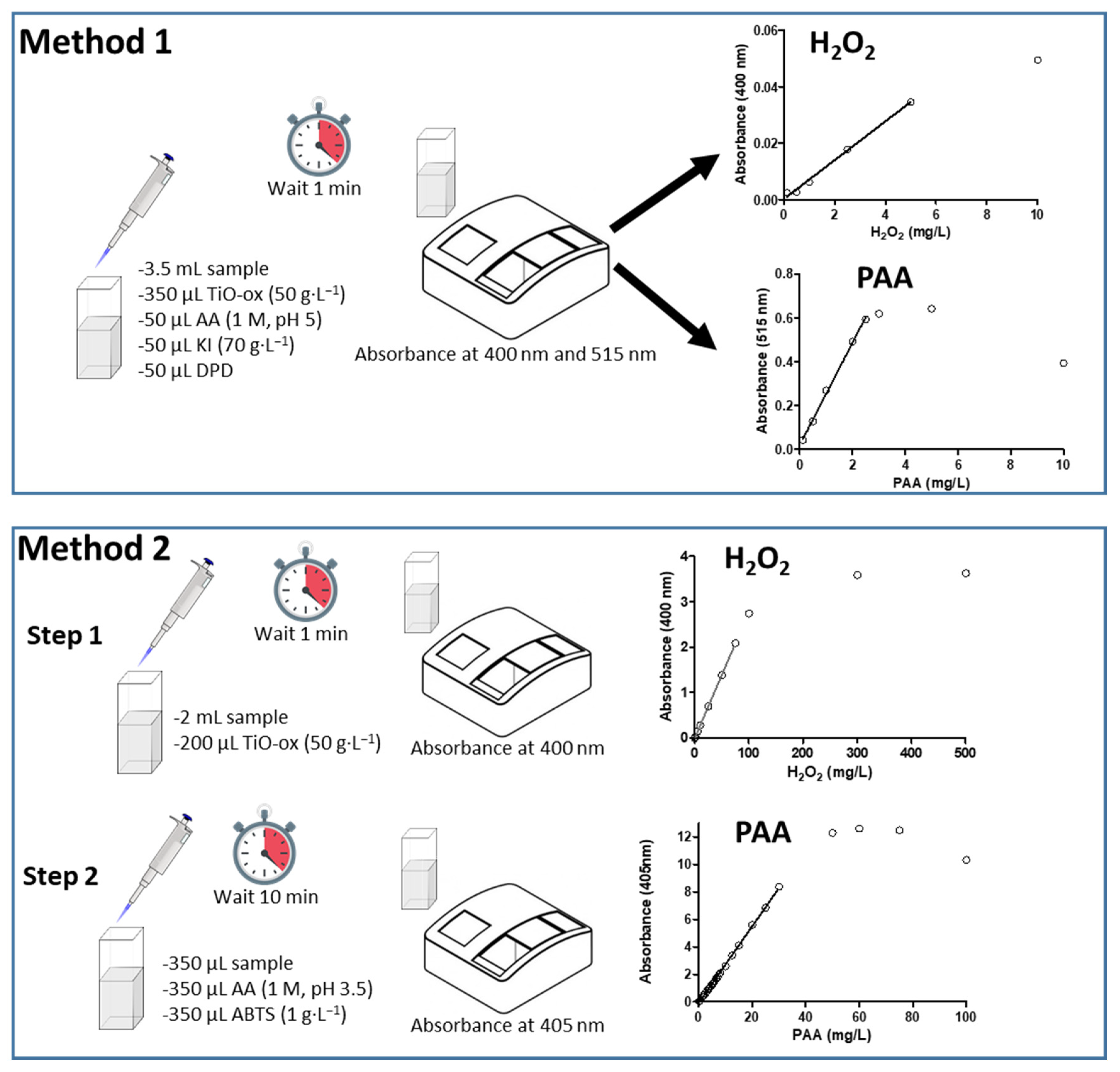
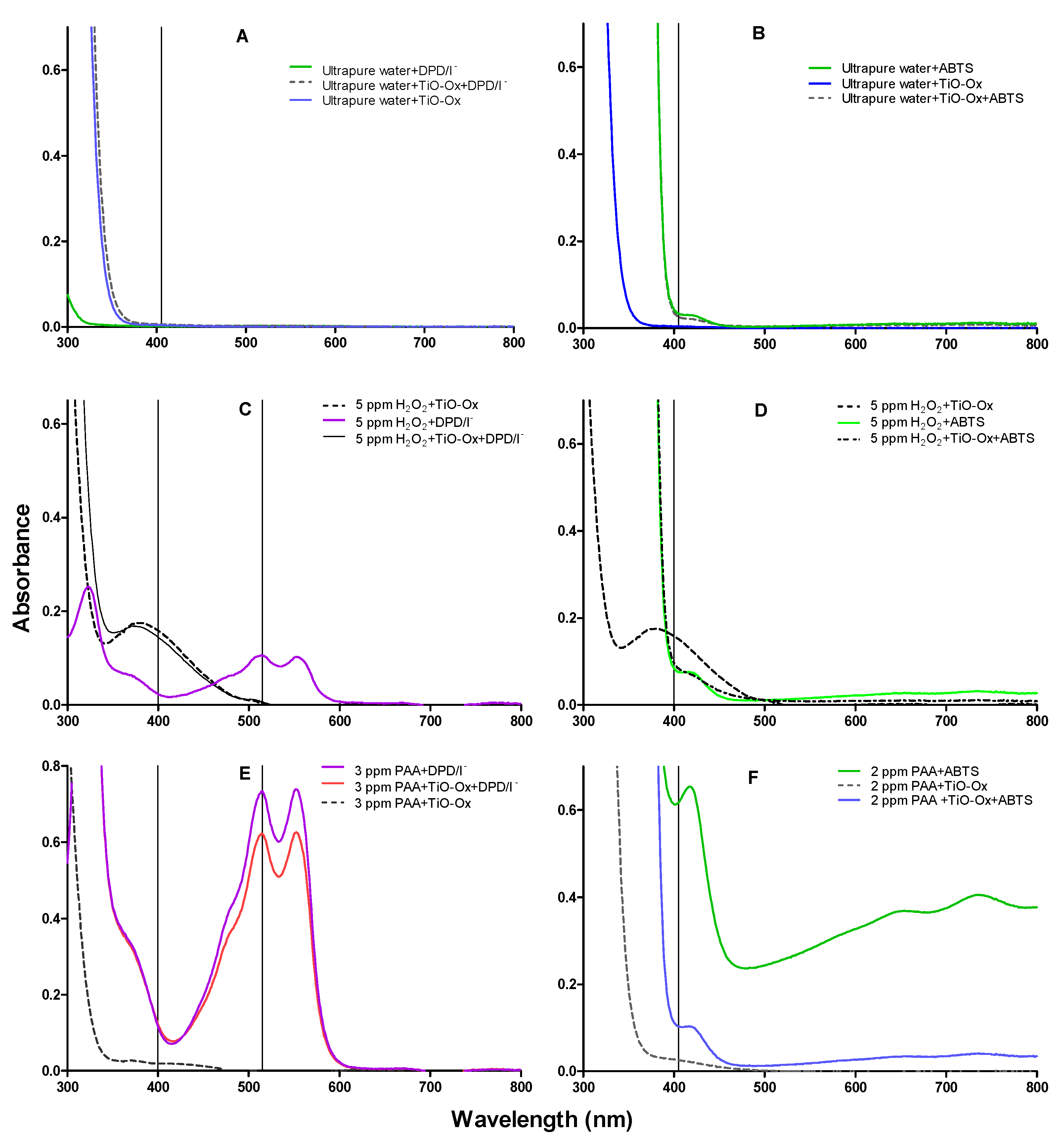

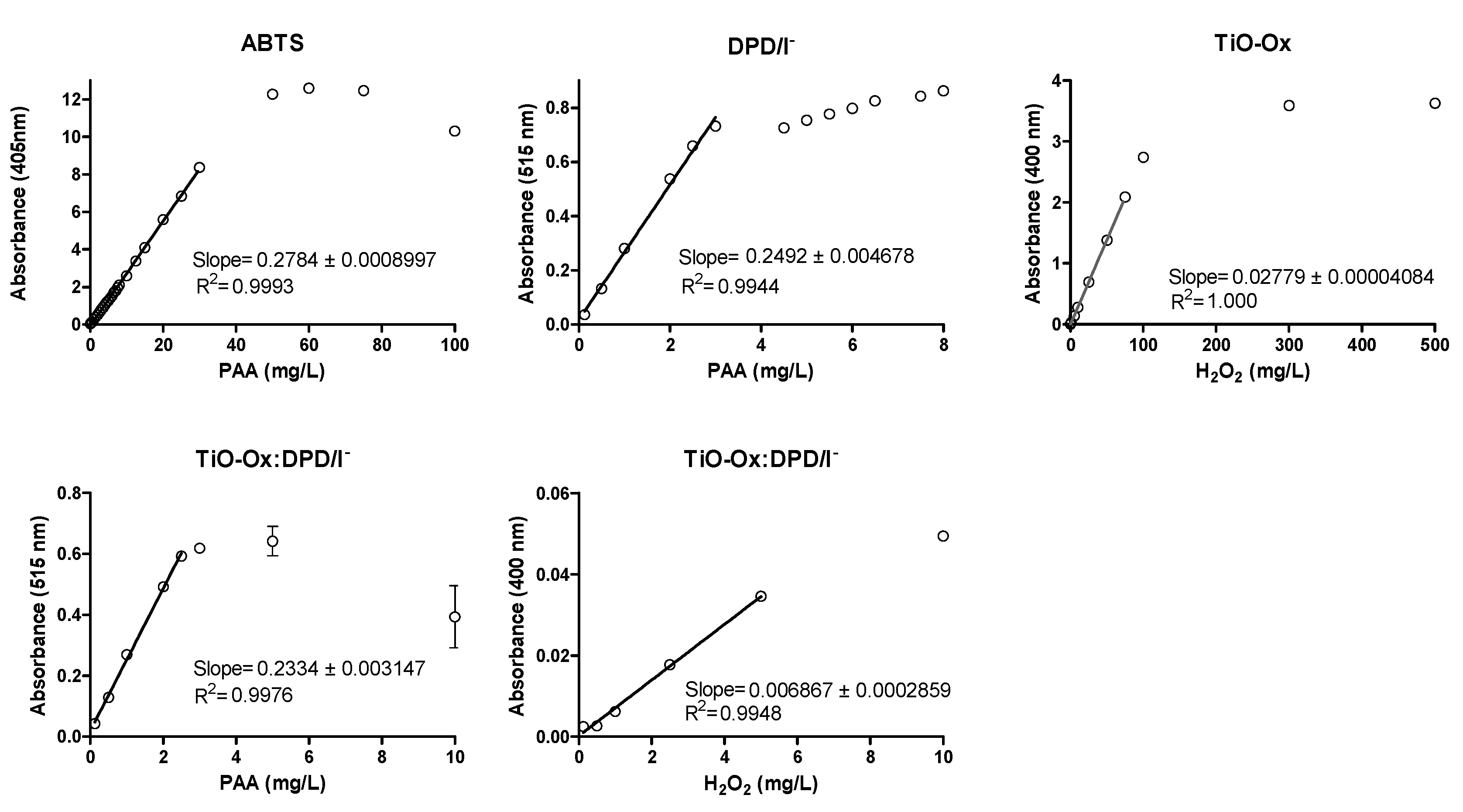
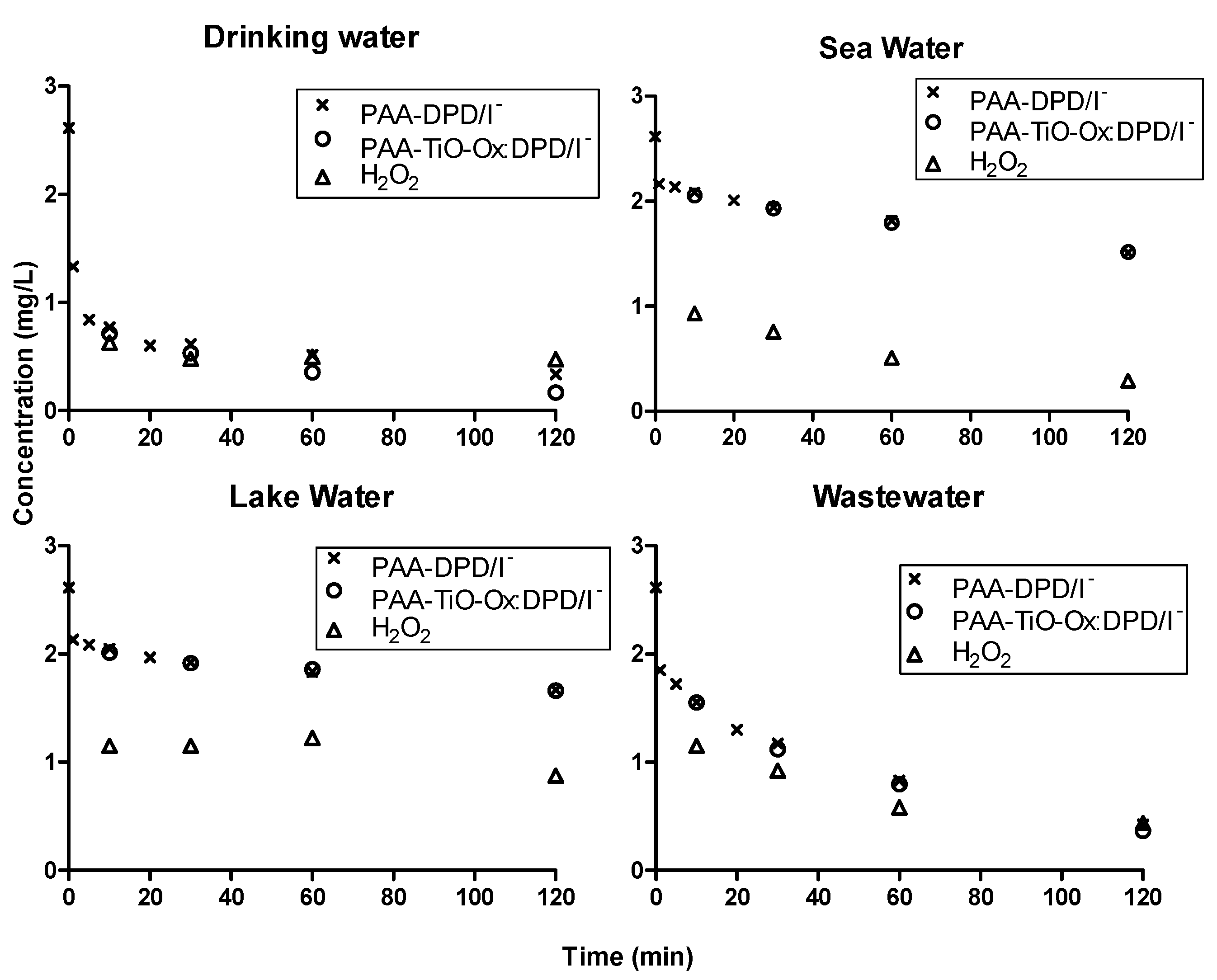
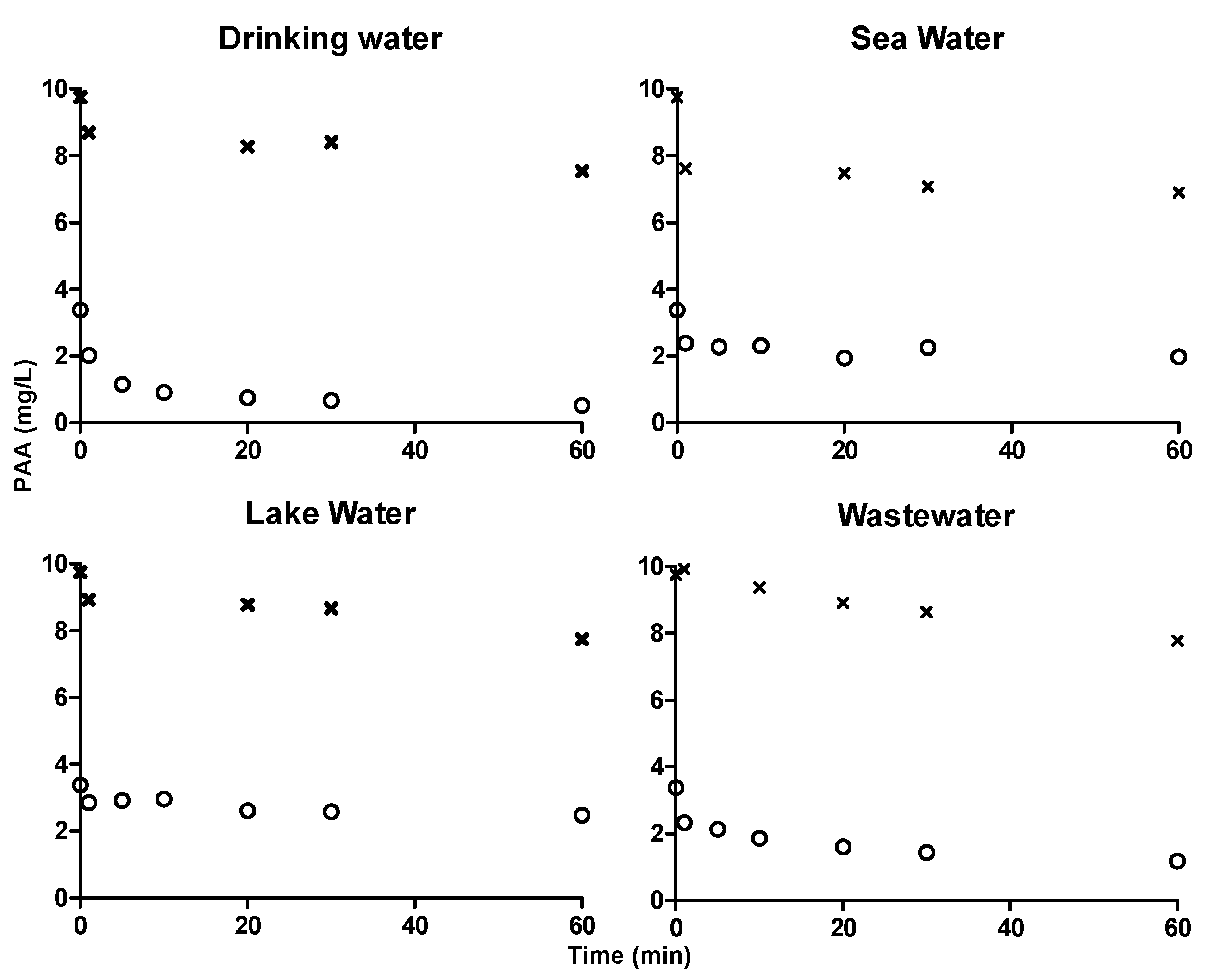
| ABTS Assay (mg·L−1) | DPD/I− Assay (mg·L−1) | TiO-Ox:DPD/I− Assay-PAA (mg·L−1) | TiO-Ox:DPD/I− Assay-H2O2 (mg·L−1) | TiO-Ox Assay (mg·L−1) | |
|---|---|---|---|---|---|
| LOD | 0.0425 | 0.0015 | 0.0024 | 0.0043 | 0.0080 |
| LOQ | 0.0500 | 0.0025 | 0.0046 | 0.0091 | 0.0127 |
| Maximum linearity | 30 | 3 | 2.5 | 5 | 75 |
© 2020 by the authors. Licensee MDPI, Basel, Switzerland. This article is an open access article distributed under the terms and conditions of the Creative Commons Attribution (CC BY) license (http://creativecommons.org/licenses/by/4.0/).
Share and Cite
Chhetri, R.K.; Kaarsholm, K.M.S.; Andersen, H.R. Colorimetric Quantification Methods for Peracetic Acid together with Hydrogen Peroxide for Water Disinfection Process Control. Int. J. Environ. Res. Public Health 2020, 17, 4656. https://doi.org/10.3390/ijerph17134656
Chhetri RK, Kaarsholm KMS, Andersen HR. Colorimetric Quantification Methods for Peracetic Acid together with Hydrogen Peroxide for Water Disinfection Process Control. International Journal of Environmental Research and Public Health. 2020; 17(13):4656. https://doi.org/10.3390/ijerph17134656
Chicago/Turabian StyleChhetri, Ravi Kumar, Kamilla Marie Speht Kaarsholm, and Henrik Rasmus Andersen. 2020. "Colorimetric Quantification Methods for Peracetic Acid together with Hydrogen Peroxide for Water Disinfection Process Control" International Journal of Environmental Research and Public Health 17, no. 13: 4656. https://doi.org/10.3390/ijerph17134656
APA StyleChhetri, R. K., Kaarsholm, K. M. S., & Andersen, H. R. (2020). Colorimetric Quantification Methods for Peracetic Acid together with Hydrogen Peroxide for Water Disinfection Process Control. International Journal of Environmental Research and Public Health, 17(13), 4656. https://doi.org/10.3390/ijerph17134656






